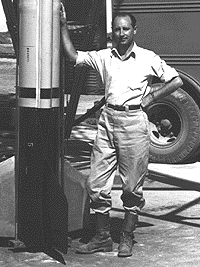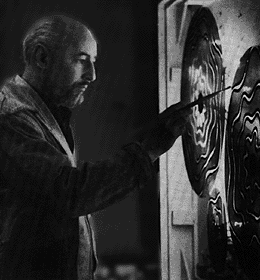Frank J. Malina 1912-1981

Dr. Frank J. Malina served as the second director of the Jet Propulsion
Laboratory, from 1944 to 1946.
This photo was taken in 1944.
Frank Malina, founder of Leonardo, was an American scientist. After receiving his Ph.D from the California Institute of Technology in 1936, Malina directed the WAC Corporal program that put thefirst rocket beyond the Earth's atmosphere. He co-founded and was the second director of the Jet Propulsion Laboratory (JPL), co-founded the Aerojet General Corporation and was an activeparticipant in rocket-science development in the period leading up to and during World War II.
Frank J. Malina in 1961 working on his Lumidyne kinetic painting 'Nebulae II. (photo P.Almasy)
Invited to join the United Nations Education, Science and Culture Organization
(UNESCO) in1947 by Julian
Huxley, Malina moved to Paris as the director of the organization's
science programs. The separation between science and the humanities was
the subject of intense debateduring the post-war period, particularly after
the publication of C.P. Snow's Two Cultures in 1959. The concept that there
was and should be a natural relationship between science and art fascinated
Malina, eventually influencing him to synthesize his scientific experience
with hislong-standing artistic sensibilities. As an artist, Malina moved
from traditional media to mesh,string and canvas constructions and finally
to experiments with light, which led to his developmentof systems for kinetic
painting.
In his work as a scientist and engineer, Malina had access to an abundance
of scholarly periodicalsthat enabled peers in any given field to stay abreast
of each other's work and to monitor importantnews developments. There was
no equivalent publication for artists, so he decided to start one. The
concept was simple---a publication by serious artists with subject integrity
secured by the samekind of peer review of articles that is common in scientific
journals. Malina felt that the demystification of modern art could, in
part, be accomplished by the free exchange of information regarding artistic
disciplines.
The Leonardo Legacy
Following Frank Malina's death in 1981, Leonardo was moved to California
by his son Roger F.Malina,
an astronomer at the University of California at Berkeley. With the support
of foundingboard members Frank Oppenheimer and Robert Maxwell, the International
Society for the Arts,Sciences and Technology (Leonardo/ISAST) was formed
in 1982. Leonardo/ISAST was created toaddress the rapidly expanding needs
of the art, science and technology community---byparticipation in conferences,
symposia, festivals and awards programs, in addition to providingsupport
for the journal Leonardo. In 1991, the publication grew from a quarterly
to a bimonthlyjournal and spawned a companion volume, the Leonardo Music
Journal, dedicated to music and thesound arts and published with an audio
compact disc (CD).
